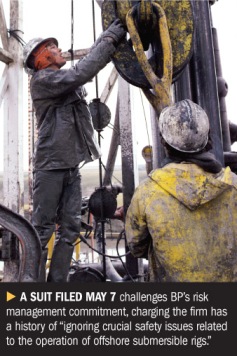Shareholder derivative lawsuits against directors and officersof British Petroleum in the wake of the company's offshore oil rigexplosion could result in sizeable recoveries based on currentlitigation trends, an expert in the field says.
|That forecast came from Kevin LaCroix, an attorney and author ofthe “D&O Diary” blog (www.dandodiary.com/), who is alsoa broker for OakBridge Insurance Services in Beachwood, Ohio.
|Mr. LaCroix said recent patterns point to the possibility of acash payout resulting from lawsuits–such as the one filed May 7 byBP shareholder Katherine Firpo, on behalf of BP, against some ofthe oil company's directors and officers and otherdefendants.
That outcome for a derivative suit brought by a shareholder onbehalf of a corporation against a third party would be a change,since historically such suits have not resulted in huge payouts andgenerally have led to agreements for remedial measures and paymentof attorney fees, he explained.
|“The question of whether there ultimately will be a cashpayout–there was a time when I would have said that's not verylikely simply because derivatives lawsuits really never resulted inhuge payouts,” Mr. LaCroix said.
|But more recently, he said significant payouts from derivativesuits were seen. He pointed to a settlement in 2008 in which formerAIG executives agreed to pay $115 million to shareholders, and a$118 million settlement of a derivative suit in 2009 involving chipmaker Broadcom as examples.
|“There's at least recent historical precedent to suggest apossibility that there could be a large cash payout,” Mr. LaCroixsaid.
|Whether there is a cash payout, he added, might depend on theavailability of directors and officers insurance for the executivesnamed in the BP suit, as well as the ultimate objective of theplaintiffs and how the case fares as it proceeds.
|The complaint filed on May 7 in U.S. District Court in NewOrleans alleges that BP has a history of “ignoring crucial safetyissues related to the operation of offshore submersible rigs,” andthat executives continued to ignore safety issues after settling aprevious shareholder derivative proceeding in 2006.
|The complaint mentions a 2005 explosion at a BP refinery inTexas City, Texas in which investigators “determined that BP hadignored its own protocols on operating the tower,” and a 2006incident where BP had to shut down its Prudhoe Bay oilfield inAlaska after oil leaked from a corroded pipeline.
|After those two incidents, the complaint states, BP continued todisregard risks.
|The suit names as defendants Anthony Hayward, chief executiveofficer and board member of BP, as well as other directors andofficers, and companies that own or have done work on the DeepwaterHorizon rig such as Transocean Ltd., Cameron International Corp.and Halliburton Energy Services Inc.
|Mr. LaCroix said he expects to see additional law firms filesimilar derivative complaints against BP's executives on behalf ofshareholders until the courts can determine a lead law firm. Hesaid a number of lawsuits were filed in the previous 2006 PrudhoeBay spill.
|But speaking to the potential for widespread D&O suits, hesaid the number of potential targets is limited to BP and a fewother vendor and service companies involved in operating andworking on the rig.
|Howard Mills, chief insurance advisor at Deloitte and a formerNew York insurance superintendent, said D&O action in oilspills such as this one could be driven by the extent of the damagethat ultimately occurs.
|He also said if a company has a history of regulatory problemsor violations, it could call risk management procedures intoquestion, potentially putting directors and officers on the spotfor how risk factors were addressed.
|Mr. LaCroix said a broader issue could be whether derivativesuits will become more common in future environmental events.
|In related news, Catlin Group has estimated its exposure to theDeepwater Horizon Drilling Platform spill will result in $40million in claims for 2010's second quarter.
|The Hamilton, Bermuda-based international specialty insurer saidthe explosion and resulting spill “is likely to be the largest lossimpacting the energy insurance market since the explosion of thePiper Alpha oil drilling platform in 1988.”
|Catlin made the estimation in its interim management statement,in which it also reported 2010 first quarter gross premiums writtenof $1.3 billion–a 9 percent increase over the 2009 firstquarter.
|The figures include a 39 percent increase in gross premiumswritten by non-London underwriting hubs, Catlin said.
|Speaking to its exposure to other catastrophes, Catlin said itestimates its Chilean earthquake exposure at $140 million, and itsEuropean Windstorm Xynthia exposure at $5 million.
Want to continue reading?
Become a Free PropertyCasualty360 Digital Reader
Your access to unlimited PropertyCasualty360 content isn’t changing.
Once you are an ALM digital member, you’ll receive:
- All PropertyCasualty360.com news coverage, best practices, and in-depth analysis.
- Educational webcasts, resources from industry leaders, and informative newsletters.
- Other award-winning websites including BenefitsPRO.com and ThinkAdvisor.com.
Already have an account? Sign In
© 2024 ALM Global, LLC, All Rights Reserved. Request academic re-use from www.copyright.com. All other uses, submit a request to [email protected]. For more information visit Asset & Logo Licensing.








